#sphere builders
Text

I just finished rewatching Star Trek Enterprise S3, aka the Xindi arc, and realized something I'd missed before. Don't know if it's been discussed elsewhere, but anyway....
The S3 story of a horrific attack on Earth by distant aliens who see humans as their worst enemy, and the Enterprise going after them to prevent Earth's annihilation, was explicitly inspired by 9/11. The showrunners said as much. Like most Enterprise fans, I've always appreciated the gradual development of the arc from a story about angry, grieving humans thirsty for revenge to one of diplomacy, mutual understanding, and cooperation.
But...cooperation against whom? Turns out there's a shadowy cabal behind the whole ugly mess. Literally shadowy. They're beings from a transdimensional realm who are transforming the fabric of space to be hospitable to their kind and uninhabitable by anyone else. They know that in the future, Earth will play a key part in defeating them, so they operate secretly and deceitfully to change the time line, manipulate the Xindi into destroying Earth, and prevent that future from coming to pass.
So...conspirators, puppet masters pulling the strings, a hidden enemy who's been there all along, controlling everything, with only their own interests at heart, causing suffering, death and destruction for their own benefit. In a story about 9/11. That's...troubling.
Almost immediately after 9/11, conspiracy theories began to circulate about who was "behind" the attack. A common one:
"The New World Order (NWO) is a conspiracy theory in which adherents believe that a cabal of powerful elites is secretly implementing a dystopian international governing structure that will grant them complete control over the global populace....Many modern-day conspiracy theories – including the NWO theory – have anti-Semitic origins....Within these narratives, Jewish people are frequently framed as the orchestrators of global events and accused of creating a supranational governing structure for nefarious purposes. These dangerous narratives are still widely promoted today....The NWO’s application within American discourse can be seen through the reaction to major events, such as the 9/11 terrorist attacks. As millions mourned, questions naturally arose as to culpable parties and their potential motives....Conspiracy theorists took advantage of the emotional turmoil to further sow their conspiratorial beliefs. NWO adherents were no exception and stood as major players in this conspiratorial competition."
-- Middlebury Institute of International Studies
No, I am not saying Star Trek writers were intentionally promoting antisemitism on Enterprise, any more than they were when they created the greedy Ferengi or the Illyrians-as-conversos. Star Trek is chock-a-block with cringy, unintentionally racist alien stereotypes, doubtless due mostly to lazy, thoughtless writing. What I am saying is that a lot of stuff floating around in the zeitgeist -- stereotypes, myths, conspiracy theories, etc -- makes its way into popular culture and implants an attitude that predisposes people to at least find it plausible that this is how things work, this is a thing that happens, this has some basis in reality. As story-telling creatures, humans are really good at finding the hidden messages and lessons. These story elements prime the pump. When people then encounter conspiracy theories steeped in bias, at least some will be disposed to think, "Yeah, sounds reasonable, an international conspiracy of Jews (or whoever) explains a lot," or at least, they'll buy into the vague notion that Jews (and Others) are disloyal, untrustworthy, etc.
So, hey, Star Trek writers, and all writers: Do better. Please.
NB: I still think Enterprise is kick-ass Star Trek. What would my life be without problematic faves?
7 notes
·
View notes
Text


getting a little crowded in the wormhole there
4 notes
·
View notes
Text
STAR TREK DISCO SPOILERS
the fuck you mean Hermitcraft survived the burn??????????????????????
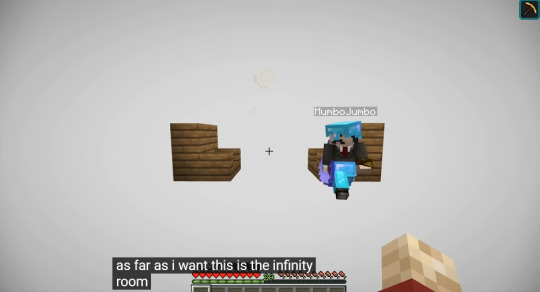
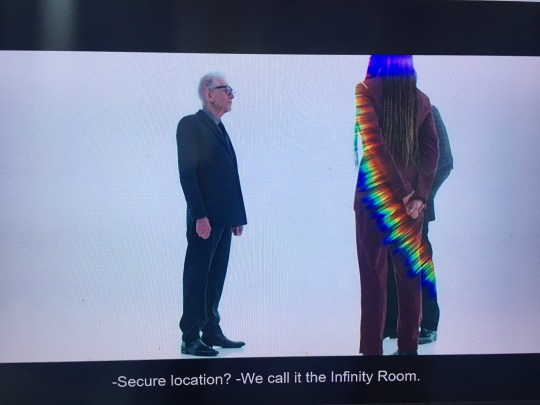
#YOU GUYS GRIAN IS CANON TO STAR TREK DISCOVERY WHAT THE FUCK ?????? HERMITCRAFT X STAR TREK?????#I expected many things out of Discovery season 5 but not this?????#i mean its pretty obvious to call it an infinity room and star trek has certainly done infinite white voids befre (Q; sphere builders)#but still i love that it has the same name#hopefully some other hermitcraft and trek fans can get a kick out of that#star trek discovery spoilers#discovery spoilers#disco spoilers#star trek discovery#hermitcraft#grian
27 notes
·
View notes
Note
what's lifesteal???
its an smp :) redacted server got me into it and im enjoying the low stakes tbh
#right now clown is starting the fucking MOB i guess#bc whats the most important currency on this server? Content!#i will say its. a different sphere from like mcrp or builder focused smps?#feels so so different#so. you know. be aware of that#asks
9 notes
·
View notes
Text
admittedly I have never liked stories about time travel but also I think the time travel is Star Trek: Enterprise’s weakest point, which is unfortunate since that’s what a lot of the Plot Episodes rely on. I don’t think you need to ~see the future~ to understand that Enterprise’s actions will have huge consequences due to its place as Earth’s first deep space ship, and I think that having more uncertainty about what will happen fits better into the theme of humanity choosing its place in the galaxy
I think that instead of aliens who can actually see the future telling the Xindi that Earth was going to destroy them, the aliens should have just been lying about it. I think that would be fun and sexy
#make the sphere-builders want to build a highway through earth#hitchhiker's guide style#star trek#star trek: enterprise#daxarve.txt
2 notes
·
View notes
Text

The SIXTH in a series of full Star Trek cast pieces is complete! Star Trek: Enterprise, featuring Captain Jonathan Archer, Commander Charles "Trip" Tucker III, Commander T'Pol, Dr. Phlox, Lieutenant Malcolm Reed, Ensign Hoshi Sato, one of the Sphere Builders, Crewman Daniels, Commander Shran, Admiral Forrest, Xindi-Primate Scientist Degra, and Xindi-Reptilian Commander Dolim.
#star trek#star trek enterprise#enterprise#star trek fan art#star trek enterprise fan art#enterprise fan art#captain archer#jonathan archer#scott bakula#tpol#t'pol#jolene blalock#porthos#porthos the dog#trip tucker#charles tucker#commander trip tucker#connor trinneer#hoshi#hoshi sato#ensign hoshi sato#linda park#malcolm reed#lieutenant malcolm reed#dominic keating#travis mayweather#ensign mayweather#anthony montgomery#dr. phlox#doctor phlox
96 notes
·
View notes
Text
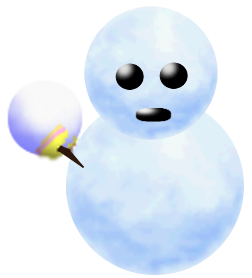
Name: Mr. Blizzard
Debut: Super Mario 64
Who ordered the Funny Snowman? Not you, because this is a blog and not a restaurant, silly! You are just so silly. But between you and me, I am a fan of Funny Snowman, so I will humor you!
Mr. Blizzard is one of the first snowmen to appear in the Mario series, and the one who would become the most iconic and recurring. This is something he should be proud of, since Super Mario 64 has a bunch of snowmen in it! But one of them based his whole identity around missing his head, and the other one is an entire location. Gimmicks that make them memorable, sure, but not very versatile for future use!

Mr. Blizzard's design really notably uses billboarding, the graphical trick where a sprite will always face the camera, giving flat circles the appearance of spheres in a slightly blurry 3D world. Snowmen are SO orbs! Some of the most orbs guys I can think of! It was a very good decision. Mr. Blizzard is honestly slightly unconventional compared to other cartoon snowmen, with no nose- nay, nary a carrot- and a simple line mouth, rather than the typical "series of dots" mouth that we know and love. Instead, it has a blank, autism creature face, with its eyes and mouth seemingly made of the same material! Mouth made of eye, or eyes made of mouth? You won't know until you kiss him on the lips!
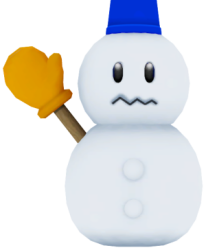
Nowadays, Mr. Blizzard uses a new design, which I also like a lot! This time he has a scraggly mouth because he is, as I assume he would say, "not too sure about this one, guys". He now has snow buttons on his torso, revealing that he was previously NAKED down there, and he also wears a bucket as a hat! That's one of those things that's so common in Japanese media, but in Western media it's always a top hat. So funny how one cartoon snowman had such influence on media! The average snowman-builder is much more likely to own a plastic bucket than a top hat!

Mr. Blizzard's main Thing is his single arm, adorned with a cute little mitten, which he uses to throw snowballs. Do you think that's like throwing his own flesh? I don't think so. If clothing buttons and igloos can also be made of snow, I think snow is just the building block of a snowman's world. But still, imagine some cattle throwing delicious meatballs at each other. Messed up! How would they even do that with hooves? Would they use their tongues like slingshots? What was I talking about? Where am I?
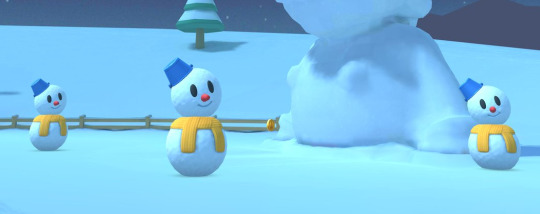
Oh yes! I am in "Snow World". Mr. Blizzard is a recurring enemy snowman, but Mario's world is also full of morally neutral living snowman, who DO have carrot noses, thank goodness. These snomonculuses are obstacles on snowy Mario Kart courses, but it's kind of rude to refer to them as that. Is a pedestrian an obstacle to a driver? Suffer, vehicles, as I wield my high level spell called "right of way"!

In Mario Kart Tour, these entities are exclusively referred to as Snowpeople! Gender? They hardly snow 'er!
190 notes
·
View notes
Text
Ivor, the social butterfly

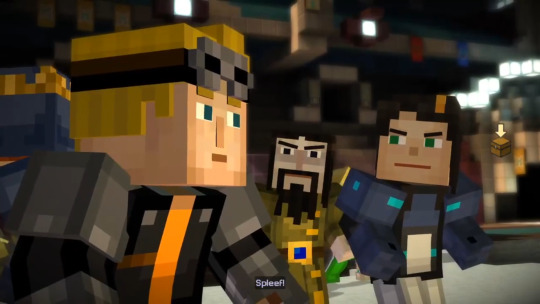
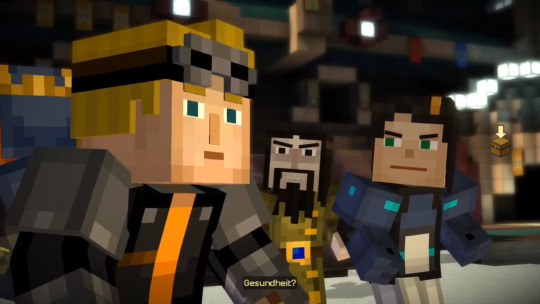
So, Ivor doesn't know what Spleef is. Until Lukas tells him that is. And that's kind of a big deal.
To be fair, this blink-and-you-miss-it moment doesn't actually help us discover anything new about Ivor as a character, but rather reinforce what we already knew. Allow me to explain.
Spleef is an incredibly well-known minecraft minigame. One of the oldest ones, way back from 2009 that defined Minecraft Multiplayer. The OG, the classic of Minecraft minigame sphere. If you play minecraft, and you don't know about it, you will. It's just that iconic. It was only a matter of time before it would be featured in Minecraft Story Mode.
Admittedly, the world of MCSM is vastly different from the meta minecraft that we're used to. The world of mcsm doesn't have an internet connection (although you could interpret the portal hallway as a network of different minecraft servers) and therefore the way characters in this world learn about the mechanics and other stuff is as limited as our real life world is. Because the characters don't have the meta we're so accustomed to (it's a whole topic of its own that I won't go into). And therefore it makes sense why the gang would not know about something as iconic as Spleef as that is likely not a part of their information pool.
Spleef (among The Walls and Deathrun) is one of the Old Builders' games. This OG status matches with our version of Spleef. So, it could be assumed that games like these would not be popular with the new generation. But Lukas is a scholar. And it makes sense for him to know about Spleef if it's something he's read in the books relating to building and architecture.
But why doesn't Ivor know? He is old. He and the rest of the Order of the Stone were the pioneers of their world. He LIVES in the Far Lands. He's old! Wouldn't he know about THE OG minigame? Well, he could have known about it, if he was interested in it.
At the end of the day, Spleef is a social game. And Ivor is anything but social. He was probably isolating himself in his lab when Spleef was popular. And his interests rarely lie in social events, so even with his giant book collection, I doubt he'd invest any time learning about games that include EUGH socialization.
I apologize if this is anticlimactic, but I thought it would be interesting to investigate, even if the answer is a nothingburger.
114 notes
·
View notes
Text
Drive to Survive Episode 10 Thoughts…
Shout out to the cameramen/women for following Charles on his climbing thing
Sorry but Charles doing that climbing reminds me of a Bob the Builder special from when I was a kid
That title sequence was the most we’ve seen of Max this season
I’m glad to see the Redbull and Alpha Tauri guys having fun
The wedding chapel- how many people actually used it?
What happens in Vegas stays in Vegas right Charles?
Harsh Christian, Harsh
This race was created for the sole purpose of keeping Danny around I’m sure of it
Of course Lando was drunk
George being confused
Typical Max can we hide?
Fred has a man crush on Toto let’s be real
OMG we actually saw the Alfa Romeo and Max!
All that hype for the drivers to keep complaining about grip
Always the fucking drain cover
Still think Sainz getting that penalty was wrong
Love that sphere
I agree Fred
ANTHONY MACKIE
No he can not convert that pole to a win
I do I’ve the Redbull Vegas livery
I think he’s please with second place
“He maybe young but he’s not dumb” 🤣
Pierre looking like a walking French flag
I need to know what that text was…
Fernando trying to get Lando to turn on Oscar
Class photo time
That shocking pit stop for Lando
The little glimpses of Mick make me smile
All the happiness the Gunthers face comes and ruins the whole mood
Max finally getting the recognition he deserves… cause he truly deserves it
#f1#formula one#formula 1#drive to survive#dts6#dts spoilers#charles leclerc#carlos sainz#scuderia ferrari#mercedes amg petronas#george russell#lewis hamilton#fred vasseur#toto wolff#max verstappen#gunther steiner#daniel ricciardo
68 notes
·
View notes
Text
Random Faction Builder
How many pies do they have their proverbial fingers in? (1d10)
1-4. They are tightly focused on their singular area of influence. Roll once on the following table.
5-6. Roll twice on the following table. The first result is the field they openly deal in, or what those who know them mostly know them for. The second result is the field they are secretly trying to infiltrate or influence.
7. They serve as a mediary between two spheres, or between certain groups within two spheres. Roll twice on the following table.
8. Roll three times on the following table. The first two results are the fields they openly deal in, or what those who know them mostly know them for. The third result is the field they are secretly trying to infiltrate or influence.
9. They’re jugglers, jacks of all trades. Roll three times on the following table for areas they regularly deal in, plus one time for a field they have their sights on breaking into.
10. They’re everywhere. Roll once on the following table for the one circle they can’t show their faces in anymore.
1d6 Circles of Influence:
1. Government/Politics/Law Enforcement
2. Religion/Faith/Cults
3. Crime/Black Market/Underworld
4. Guilds/Trades/Organized Labor
5. Business/Merchants/Corporations
6. Knowledge/Information/Research
Now, roll 4d6 and assign one die to each of the following attributes, then look at the total on the last table:
Group Size
1. Just a few people devoted to a cause.
2. Enough people that it’s hard to get them all in a meeting together, but not enough people to really split into multiple sub-groups.
3. Enough people to crew a large vessel
4. A pretty big group, church congregation sized.
5. Enough people to populate a neighborhood.
6. If this entire group mobilized it would be a full-scale army.
Financial Power
1. Broke. It’d be a dream just to break even.
2. Surviving. They can get what they need, but can’t afford to expand or to have a large unforeseen expense.
3. Middling. Can use money to further their agenda but must be selective about doing so.
4. Comfortable. This group can afford to make investments.
5. Well-off. Their investments are paying off.
6. Rolling in it. They can solve most problems by throwing money at them.
Age of Faction
1. Brand new. This faction hasn’t existed long enough to have done anything of note.
2. Recent. This faction is probably still made up mostly of founding members, but has had time to make a name for itself.
3. Established. People remember this faction being founded. It may have some original members, but if it does they are old.
4. Pretty Old. This group was established before the oldest currently living generation was born, but in the lifetime of their parents or grandparents.
5. Old. This group was founded hundreds of years ago and has played a roll in many historical events.
6. Ancient. This group may predate the current civilization, and is seen all throughout history books.
Expertise
1. Bumbling. This group is incompetent and lacks basic knowledge.
2. Shoddy. They know just enough to get themselves into trouble.
3. Mediocre. There are no experts in this group but they have meaningful skills.
4. Competent. This group employs some actual experts but still has real gaps in their abilities.
5. Highly skilled. They may not be the absolute best in the business but this group can use skill to address most challenges.
6. Only the Best. This group has a reputation for their expertise.
Total - Overall Faction Influence
4-8 Nobodies. Who even are these losers?
9-12 Small fish in a big pond. This faction has an impact on certain individuals or niches, but are still unimportant enough that none of the big players pay them any mind
13-16 Up and Coming. Enough influence that they need to be careful not to upset the highest tier factions lest they get squashed.
17-20 The big leagues. This faction has a great deal of power but is not infallible.
21-24 Powerhouses. If there is only one faction at this level, they are functionally in charge of the society. If there are multiple factions at this level, their conflicts and machinations can have devastating fallout for ordinary people.
#random table#random tables#ttrpg#ttrpg community#ttrpg homebrew#homebrew#fantasy#dnd#d&d#dungeons and dragons#dnd homebrew#dnd table#npc#npcs#random npcs#random npc table#people#characters#random worldbuilding#worldbuilding#ttrpg worldbuilding#genre neutral#factions#faction building#random factions#faction generator
350 notes
·
View notes
Text
I saw this article pop up online and apparently we're getting a Brandon Sanderson inspired deck builder game? Does anyone in the cosmere tumblr sphere know how legit this is?
It'd be kinda neat though, I like deck building games when done right
57 notes
·
View notes
Text


Star Trek Enterprise "The Council"
#Star Trek Enterprise#Enterprise#The Council#Degra#Sphere Builder#entedit#enterpriseedit#startrekedit#GIF#my gifs#secret enterprise rewatch#Hide and Queue
17 notes
·
View notes
Text
Halcyon Druid (Druid Archetype)
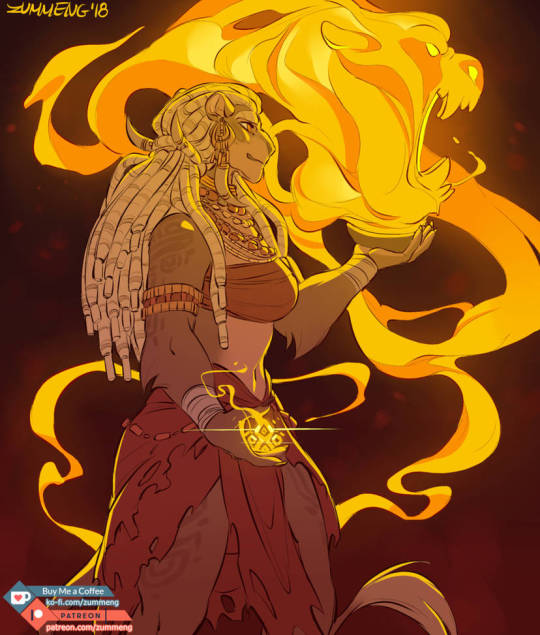
(art by Zummeng on DeviantArt)
Easily one of my favorite goodly organizations in the Lost Omens setting is the Magaambya school of magic. Founded by the man who singlehandedly saved arcane magic for humanity, Oldmage Jatembe’s school of magic is the very picture of a place where the mystic arts are paired together with a righteous code of ethics and goodness.
But that isn’t the only thing that is combined there in that sacred institute, for the school is also famous for blending the arcane and divine, with many of it’s mages being able to cast druidic primal magics in addition to their arcane arts.
However, Magaambya does not merely teach the arcane arts with a smattering of the divine, they actually teach all manner of disciplines, so it only makes sense that there would also be druids that learn a bit of the arcane.
These so-called halcyon druids not only learn a few arcane spells, but they also do something very atypical for primal mages: they seek out contact with outsiders of the outer sphere, particularly celestials, and especially the animal-like agathions!
The only other druid archetype I can think of that deals with non-elemental outsiders regularly is the planar extremist, and that’s the ex-druid archetype representing those that have gone too far away from their roots and become servants of the planes rather than nature, so in order to truck with such beings while still being true druids, these mystics must be doing something very right compared to others.
As we will soon see, these mystics gain a mixture of powerful abilities from their primal, arcane, and divine sources.
Rather than form a bond to an aspect of nature or a companion, these druids instead bond with their mask, which then functions similar to a wizard’s bonded item, and can be similarly enchanted.
They are also trained diplomats, all the better to go between villages and nations to forge new bonds of cooperation and kinship.
In keeping with the blending of magical traditions, these mages can spontaneously cast spells associated with the cleric domain of Good instead of summoning allies.
They also learn a handful of spells exclusive to the arcane arts, diversifying their magecraft further.
As agents of good, these mages are especially resistant to the depredations of fiendish foes.
Finally, these mystics gain the ability to shapeshift into a form of celestial outsider based on their mask. While this is not a true outsider polymorph effect, it has the limited ability to mimic some of the iconic abilities of the major celestial types, such as the aura of menace seen in archons.
This archetype is interesting. It gets rid of wild shape and the nature bond, but replaces them with surprising spell versatility and their very own bonded item, as well as making them experts in social areas. These changes mean that you’re pretty much limited to being a back line spellcaster unless you utilize lots of buffs or use the celestial transformation from your mid-levels, but it still can be rewarding to play.
Interestingly, this archetype mentions that some members of this order wear masks resembling fiends rather than celestials, though those that do are probably more akin to gargoyles, acting as representatives of what evil looks like rather than being evil themselves. However, there is always the possibility of perhaps some disgruntled ex-student actually making pacts with fiends.
Ogwe the Crocodile is especially daring among his kin, but that boldness has led to surprising alliances in the past. Now the druid seeks perhaps his most shocking diplomatic endeavor yet: delving into the earth beneath the region to meet with a mighty vault builder, one of the legendary xiomorns, to secure peaceful relations.
Though sometimes mistaken for a rakshasa, Veldikas is every bit a mystical dilletante and social navigator. However, his true loyalties always lie with the natural world, and the fanglord beastkin wears the face of the tiger both in and out of his sacred mask, especially when the time comes to act.
For generations, the angelic mask of her ancestor has watched over Kifi’s home, protecting it. Turns out this was more than superstition, for the day the mask was stolen, her village was attacked. Though she managed to get the mask back, she discovered a divine spirit dwelling within, one that urges her to seek out the mentor that trained their ancestor so long ago.
23 notes
·
View notes
Photo
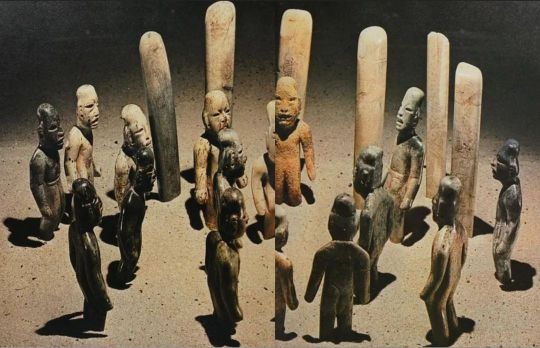
Early master builders: The Olmec. "This group of figures are ritual objects of the Olmec. They were found deep in the ground beneath the La Venta cult center. The statuettes, about 20 centimeters high, were even closer together than in this picture, but their concentric arrangement was the same. The 15 loading figurines are assembled in front of a 16th one made of red stone. This stands in front of a kind of palisade of six loading axes. Does it represent a priest speaking to believers? Or a prisoner about to be executed? What this dramatically moving scene means has not yet been clarified. ...The Olmec culture developed 3,500 years ago on the south coast of the Gulf of Mexico, in the hot, humid swamp regions of what is now the state of Tabasco. Through wars and conquests, the Olmecs continued to expand their sphere of influence, in the east to the area of the Maya, in the south to the land of the Zapotec. Olmec culture spread even as far as Teotihuacán, the great metropolis in the northwest, and El Tajin, the capital of the Totonacs. Historically, it was the cradle of the pre-Columbian cultures of Central America, the mysteries of which archaeologists are far from unlocking." From "The last mysteries of our world", 1989. https://www.instagram.com/p/CpgDc1RNpdv/?igshid=NGJjMDIxMWI=
65 notes
·
View notes
Note
Hey there! I saw your post about feeling down on yourself for “just being another fandom creator” and wanted to take the time to explain what I think makes you spechail a unique! (At least to me personally <3) I do not even own a copy of bg3 (or any of the previous baulders that may or may not exist) but I fallow you so I am frequently shown other peoples gortash art etc. but I never find myself interested, on the other hand your self destructive little body builder man IS one of my BIGGEST comfort characters right now. Not because of his affiliation with a popular game but because I see myself in him, because I care about his struggles and his ups and downs, I get a huge boost when I see you post every day not cause I’m looking forward to fandom content but cause I WANNA KNOW HIW MY FAVORITE CELEBRITY COUPLE IS DOING GODDAMN IT!!! I want to see the interactions and nuances you have built. I want to see them struggle at love, I want to see them fuck I want to see them grow emotionally despite themselves!(I wanna watch gort become a sphere). I can quite honestly tell you I am incapable of give it a flying fuck about cannon gortash cause yours is more interesting and far more endeared to me. I do not particularly care about the world of baulders gate because there is no Cas makeing everyone around him uncomfortable with his socially responsible behavior.
As far as I am concerned you have made a world separate from the original property. A fascinating and nuanced world where a hunky gremlin can find love through his toxic egomaniacal fetishistic behavior. And I love him and you for it!
And as an artist who sometimes dose fanart of popular properties (and used to be locked into a neich fandom) I understand thinking people only like your work because it’s “from that one thing”. It’s an awful feeling. But I can say with confidence that I like your work for the impeccable balance of story and kink that YOU specifically bring to YOUR work, and for that psychosexual nightmare of a beefcake you cooked up in your beautiful brain!!
You have made a unique and complex character, that at least one person out there can see themselves in! Which as far as I’m concerned means you are one hell of an artist!
With all the love a tired old cartoonist like me can give.
Keep up the amazing work.
A ton of us love Cas for Cas, and your art for you <3
Ps: I’m sorry that was long I’m just passionate, I don’t understand or really want to under bg3 but your art just got me though one of the worst months of my life, like fired from job loved one in the hospital bad, your horny and yet emotionally complex art is out here saving lives and doing gods work man.
wow, I honestly don't even know where to start responding to this so just... thank you, truly. As genuine as possible this means so much to me. Not ashamed to say I read this more than once today to get my mind off things so thank you so so much for taking the time to send this to me, it'll be on my mind for a while.💜
18 notes
·
View notes
Text
As Russia’s war against Ukraine approaches its third winter, there is still no end in sight. The drip feed of Western military aid is enough for Ukraine to keep fighting but insufficient to liberate all its territory. At the same time, despite continued popular support for Kyiv’s cause in Western countries, there is plenty of talk about Western war fatigue, with increasing behind-the-scenes debate about a possible compromise to end or freeze the war.
A compromise would be premature for a number of familiar reasons. First, neither side is ready for serious negotiations. Regaining control over Ukraine may not be existential for Russia’s survival, as Russian President Vladimir Putin has claimed, but it could very well become a matter of life and death for Putin himself. For Ukraine, the fight is existential, and Western leaders have said again and again that it is for Ukraine to decide when to negotiate and on what conditions. That mantra is flawed, however, since we already know that Ukraine wants to keep fighting. By holding back on crucial weapons deliveries, Western countries are partly responsible for Ukraine not advancing as fast as it and its supporters would wish.
Second, violence in Russian-occupied territories will not stop as long as these territories remain under Moscow’s control. Freezing the conflict is therefore a non-starter for the Ukrainians who have seen the horrors perpetrated by Russians in Bucha, Irpin, and countless other towns and villages. This is well understood by Ukraine’s neighbors, which have their own experience of Russian and Soviet occupation. It means living under fear, unfreedom, and the constant threat of violence.
These arguments against seeking a settlement any time soon will be familiar to readers following the war. Less discussed—but much more fundamental for all of Europe—is what a settlement would mean for the future European security order. If the war were frozen, not only would Russia be rewarded for its attack. It would also hold on to its goal of fundamentally revising the European security order and reestablishing its sphere of influence.
It should be very clear that Moscow’s understanding of the principles and norms of European security is incompatible with Western views. As we can see in Ukraine, the Kremlin equates security with control, which has deep roots in Russian history and foreign policy. This is unlikely to change in the foreseeable future.
The tradition of Russia as a land-hungry empire goes back in a straight line to medieval Muscovy, which transformed into an expansionist state under the rule of Ivan the Terrible in the 16th century. Ivan, also known for his cruelty in torturing and massacring his own people, has been rehabilitated and celebrated under Putin’s rule, while Putin himself has adopted another torture-loving Russian empire builder, Peter the Great, as his role model.
Another key Russian foreign-policy tradition is the idea that the European security order should be based on agreements among the major powers over the heads of smaller ones. Since 2014, the Kremlin has repeatedly made references to the Congress of Vienna, which redrew the map of Europe in the early 1800s, and the Yalta Conference, the British-Soviet-U.S. meeting in February 1945 that divided Europe into two spheres of influence. From the Russian perspective, both agreements laid the foundation for decades-long stability. The price of that stability, however, is painfully known to the countries affected by Russian domination. The Vienna agreement wiped Poland off the map as a sovereign state for a century, and Yalta doomed half of Europe to more than 40 years of Soviet occupation and totalitarian rule.
Europe’s post-Cold War order has brought unprecedented levels of freedom, sovereignty, and prosperity to Russia’s western neighbors. Most of the former Eastern Bloc countries used their sovereignty to make a decisive turn to the West. Among the former Soviet republics, the Baltic states’ Western turn was fast and determined; Ukraine, Georgia, and Moldova tried to follow later and are still struggling for the right to choose their future place in Europe, including membership in the European Union. The EU’s decision-making structures underpin a fundamentally different order compared with being part of a Russian-controlled zone: The bloc gives substantial power to smaller states, even as members delegate some aspects of sovereignty to supranational institutions. Staying in the gray zone between Russia and the EU, as Ukraine has done, proved to be the least stable option.
Russia never felt comfortable with post-Cold War developments in European security. It frequently complained about not being treated as an equal by the West—yet Russia’s and Europe’s definitions of equality are very different. For Russia, it means being on par with other great powers, notably the United States, and not with its sovereign neighbors, whose agency it has consistently denied. Because it does not see them as equals, Moscow also has little interest in what Berlin or Paris has to say, let alone Brussels. That clouds every aspect of how Russia views its neighbors. When hundreds of thousands of Ukrainians took to the streets during the 2004 Orange Revolution to protest against their corrupt and dishonest government—and again during the Maidan Revolution in late 2013 and early 2014—all Moscow could see was a supposed U.S. plot to weaken Russia.
In 2009, then-Russian President Dmitry Medvedev proposed a new European security treaty in an attempt to defend what Russia considered its legitimate security interests, now allegedly being trod on by the West. Using code language such as “indivisibility of security,” what Moscow really seemed to seek was to confine NATO to the Cold War-era West and gain veto right over the alliance’s decisions if Russia considered them contrary to its very different definition of security.
In December 2021, as Russian forces were massing to invade Ukraine, the Kremlin made a renewed attempt to promote its vision of a European security order in two documents addressed to NATO and the United States. This time the ambiguity was gone and the revisionist aims clear: a full restoration of Moscow’s Cold War-era sphere of influence and the pushback of NATO’s presence in Europe to the line before its eastward expansion in the 1990s. These aims remain unchanged and reflect Russia’s long-term strategic thinking. Western efforts since the Cold War to build a common European order with Russia have clearly failed.
If Russia achieves its strategic goal of reestablishing control over Ukraine, even in part, it will ratify Russia’s efforts to impose its vision of order on its European neighbors. But even if Russia is defeated and has to leave all occupied territories in Ukraine, it will not easily give up its centuries-old understanding of itself as an empire and major power entitled to privileged rights in its sphere of influence. Unlike some empires that were wound down in the past—such as Nazi Germany and imperial Japan—Russia will not be totally defeated. It will not be occupied by foreign powers or be forced to go through a profound system change. Russia’s imminent transformation to a status quo power that accepts its post-Cold War place in Europe, let alone further enlargement of the EU and NATO, is therefore unlikely.
Former U.S. National Security Advisor Zbigniew Brzezinski famously argued in the 1990s that Russia cannot be an empire without Ukraine. Russian propagandists claim that Russia can only exist as an empire or not exist at all. Rejecting this claim will be an essential precondition for a post-imperial Russia to emerge.
Another precondition will be for Russia to acknowledge its neighbors as sovereign states and not mere puppets doing Washington’s bidding. Where the Kremlin—echoed by so-called realists in the West—is profoundly wrong with regard to its Ukraine war is the idea that world history is written by the major powers. If that were true, the Baltic states, Finland, Poland, and Ukraine would have no reason to exist today as sovereign states. One of the big unintended consequences of Russia’s invasion of Ukraine is that it has demonstrated and strengthened the agency of Russia’s neighbors. A new power bloc in NATO now stretches from Scandinavia to the Black Sea. Poland and Ukraine are becoming leading military powers in Europe. Their contribution to European defense will be much needed in coming years and decades.
We should not expect a common understanding between the West and Russia on European security to emerge anytime soon—and certainly not as part of a negotiated agreement that would at least partially reward Russia for its dismemberment of Ukraine. It is therefore necessary to envisage a future European security order not with Russia but against it, aimed at deterring further Russian threats and defending European democracies against the Kremlin’s authoritarian, revisionist, and imperialist ambitions.
This would be a dual order similar in some ways to the Cold War era. Then, Western democracies created their own liberal rules-based structures, notably NATO and the EU, while pursuing a containment policy against the Soviet Union and engaging in ideological, economic, military, and technological competition with the Eastern Bloc. Such a new European order would, however, be inherently unstable, not least because the global context has profoundly changed since the Cold War. The United States’ commitment to European security is undermined by both domestic political turbulence and a geostrategic environment where the main U.S. competitor is now China, not Russia. At the same time, the world is no longer bipolar but has multiple competing and interconnected centers of power.
In spite of these changes, the future European order will most likely be characterized by a long-term Russian threat and an antagonistic relationship with Moscow, much as during the Cold War. Russia will continue to reject a new balance of power that shrinks its former Soviet and tsarist sphere of influence, while the West will continue to reject the very principle of spheres of influence. Russia would seek to revise the balance of power as soon as it rebuilds its military capability. In order to make the new order in Europe more sustainable, the West will need to pursue a proactive containment policy, including credible deterrence and defense, full integration of Ukraine and other countries in NATO and the EU, and restrictions on Russia’s ability to restore its military strength.
No matter where one stands on negotiations between Russia and Ukraine, the fundamental question of Europe’s future security order cannot be ignored.
12 notes
·
View notes